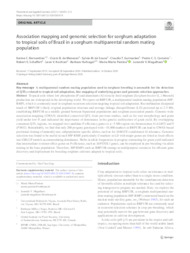Association mapping and genomic selection for sorghum adaptation to tropical soils of Brazil in a sorghum multiparental random mating population.
Association mapping and genomic selection for sorghum adaptation to tropical soils of Brazil in a sorghum multiparental random mating population.
Author(s): BERNARDINO, K. C.; MENEZES, C. B. de; SOUSA, S. M. de; GUIMARÃES, C. T.; CARNEIRO, P. C. S.; SCHAFFERT, R. E.; KOCHIAN, L. V.; HUFNAGEL, B.; PASTINA, M. M.; MAGALHAES, J. V. de
Summary: Tropical soils where low phosphorus (P) and aluminum (Al) toxicity limit sorghum [Sorghum bicolor (L.) Moench] production are widespread in the developing world. We report on BRP13R, a multiparental random mating population (MPRMP), which is commonly used in sorghum recurrent selection targeting tropical soil adaptation. Recombination dissipated much of BRP13R?s likely original population structure and average linkage disequilibrium (LD) persisted up to 2.5 Mb, establishing BRP13R as a middle ground between biparental populations and sorghum association panels. Genome-wide association mapping (GWAS) identifed conserved QTL from previous studies, such as for root morphology and grain yield under low-P, and indicated the importance of dominance in the genetic architecture of grain yield. By overlapping consensus QTL regions, we mapped two candidate P efciency genes to a ~5 Mb region on chromosomes 6 (ALMT) and 9 (PHO2). Remarkably, we fnd that only 200 progeny genotyped with~45,000 markers in BRP13R can lead to GWAS-based positional cloning of naturally rare, subpopulation-specifc alleles, such as for SbMATE-conditioned Al tolerance. Genomic selection was found to be useful in such MP-RMP, particularly if markers in LD with major genes are ftted as fxed efects into GBLUP models accommodating dominance. Shifts in allele frequencies in progeny contrasting for grain yield indicated that intermediate to minor-efect genes on P efciency, such as SbPSTOL1 genes, can be employed in pre-breeding via allele mining in the base population. Therefore, MP-RMPs such as BRP13R emerge as multipurpose resources for efcient gene discovery and deployment for breeding sorghum cultivars adapted to tropical soils.
Publication year: 2021
Types of publication: Journal article
Unit: Embrapa Maize & Sorghum
Keywords: Gene, Genética Vegetal, Melhoramento Genético Vegetal, Seleção genômica, Sorgo
Observation
Some of Embrapa's publications are published as ePub files. To read them, use or download one of the following free software options to your computer or mobile device. Android: Google Play Books; IOS: iBooks; Windows and Linux: Calibre.
Access other publications
Access the Agricultural Research Database (BDPA) to consult Embrapa's full library collection and records.
Visit Embrapa Bookstore to purchase books and other publications sold by Embrapa.

